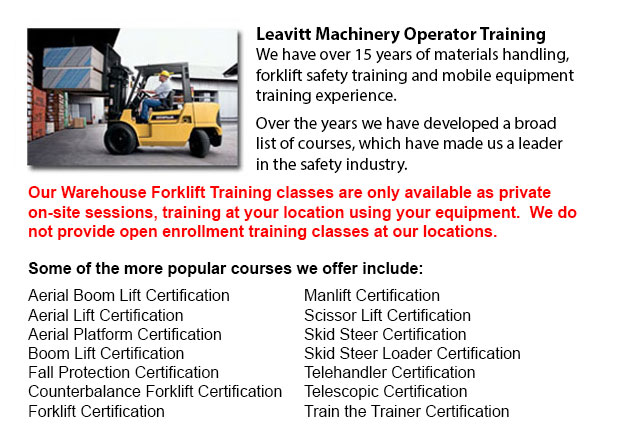
Mississauga Warehouse Forklift Training Programs - Warehouses could either be retail, industrial or commercial facilities, functioning from product distribution services to bulk product retailing. Regardless of the kind of warehouse, staff in warehouse settings should be well trained in safety measures related to material storage and handling, loading docks, conveyor systems, and forklifts and pallet jacks. Good housekeeping is essential to a safe and orderly warehouse environment.
Truck and loading dock systems are often located at a height from the ground. Products exit and enter warehouses through these systems where staff unload and load materials from elevated docks and ramps. Particular attention must be paid to safety practice in this stage. In order to prevent falls, install yellow striping along the edge of docks and ramps. Pay attention to the area all-around delivery trucks that are parked at the loading dock, specifically the area between truck and dock. Be certain that truck wheels are chocked when unloading.
Some warehouses make use of conveyor systems to distribute products inside the facility. Conveyor systems have moving belts and wheels which pose a pinch point danger. Keep parts of the body and hair far away from conveyors to prevent injury. Elevated conveyors pose a danger to staff underneath if safety nets are absent. Workers ought to know how to stop conveyors in the event of emergency. Be aware of the location of emergency stop buttons and off switches. When servicing conveyors, tag out/lock out procedures are mandatory.
To be able to make it easier to move supplies, pallet jacks and forklifts are most usually used. The lift truck operator would require training and certification. Operators of pallet jacks do not require certification, but should be trained about the equipment. Training courses instruct operators in the correct methods for hoisting things and transporting them to their assigned location. Neither forklifts nor pallet jacks must ever be used to transport or lift personnel.
Storage shelving and rack systems help to create an orderly and efficient work space if they are braced, sturdy, and allow enough room for individuals and machines to pass. Careful and slow placement of good is required to prevent accidents caused by products falling off the facing aisle. Aisles must be kept clear by storing products flat and inside the shelving units. Pallets are utilized for stacking products. They should be in good condition, and palleted products must be baled or shrink-wrapped, whenever possible.
PPE or likewise referred to as personal protective equipment should be worn when needed to help protect the employees' limbs, heads, feet and hands. Hard hats or bump caps, steel-toed shoes and gloves are common PPE.
Slippery floors which are pocked with pits and dents can present significant dangers, making good housekeeping very essential. Warehouse docks and floors should be clear of oil, dirt and debris. The area should be kept clear of baling materials, trash and boxes.
-
Mississauga Crane Training Courses
Mississauga Crane Training Courses - The heavy equipment crane is intended to move, lift and lower heavy stuff. Normally, the crane comes outfitted along with a hoist, sheaves, and chains or wire ropes. Cranes are utilized in the manufacturing, const... More -
Mississauga Telehandler Ticket
Mississauga Telehandler Ticket - The telescopic handler or telehandler is a normally utilized machine in agricultural and industrial applications. This machine is the same in look to a forklift and even works in a similar way, even though telehandler... More -
Mississauga Overhead Crane Ticket
Mississauga Overhead Crane Ticket - An overhead crane is normally used in industrial environments. Likewise referred to as a bridge crane, this equipment includes parallel runways spanned by a traveling bridge. The component that lifts materials is t... More -
Mississauga Forklift Safety Training
Mississauga Forklift Safety Training - Any person who wants to operate a lift truck has to take a forklift safety training program in order to become a certified forklift truck operator. There are various ways to acquire forklift training. Courses ar... More -
Mississauga Heavy Equipment Training
Mississauga Heavy Equipment Training - Normally, the different kinds of heavy equipment training are divided into 2 categories of equipment: those that have rubber tires and tracked vehicles. Tracked vehicles include items such as excavators, cranes,... More -
Mississauga Loader Ticket
Mississauga Loader Ticket - Loaders have been created to operate practically anywhere. They offer optimal traction and maneuverability because of a heavy-duty oscillating joint which offers 45-degree rotating angles toward the left and right, with 10... More -
Mississauga Boom Lift Certification
Mississauga Boom Lift Certification - Elevated work platforms allow maintenance operations and work to be done at levels which can not be reached by whichever other means. Boom Lift Certification Training educates workers about safely operating boom... More -
Mississauga Forklift Training School
Mississauga Forklift Training School - Why A Forklift Operator Must Take A Forklift Training School - Federal and industry regulators have established the criteria for forklift safety training based on their existing standards and regulations. People... More

Forklift Certification Mississauga
TOLL FREE: 1-888-254-6157
Mississauga, Ontario
forkliftcertificationmississauga.com
Email Us
About Us


